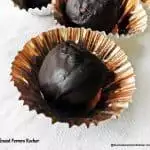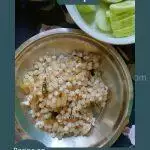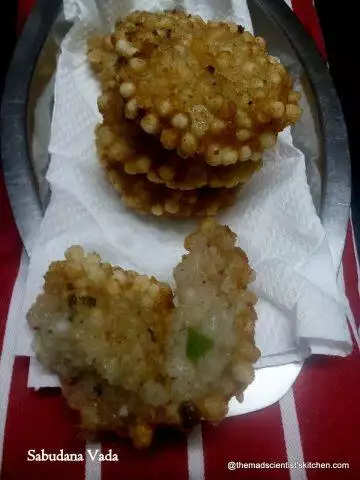Sabudana Khichdi is a tummy-filling vrat or upvas (fasting) recipe. You can consider it as a pulao made with sago pearls. Sago is full of yummy carbs and is very popular for Navratri.

Sabudana Khichdi used to hold centre stage at my place regularly. Once made, it was breakfast, lunch, and dinner. Everything else would end up in the bin. Now with the girls living away, I make it as an occasional treat.
At home, we make this sabudana khichdi recipe for fasts, so I add no onion or garlic. My mother-in-law was scandalised when hubby insisted it should be made with onions. But you can definitely try it! My daughter, Apeksha loves Farali Misal. That’s always a delicious add-on. If you really like the flavour of sabudana, you can also try sabudana wada or sabudana thalipeeth.
Making this pilaf is easy, but it can be your worst nightmare if you don’t do it correctly. A well-done sabudana khichdi is soft and translucent, yet each grain is separate. If you mess it up, it’ll quickly turn into a sticky, lumpy mess. I have tips for making non-sticky, but soft sabudana khichdi; one is my mother-in-law's secret. Try it and let me know how you like it!
Ingredients
These are your ingredients for quantities please check the recipe card.
- Sabudana: also called sago or tapioca pearls. You get them in different sizes small, medium and large. I prefer to use the medium-sized ones.
- Roasted peanut powder: it’s what prevents the khichdi from becoming sticky.
- Potatoes: I use boiled, peeled and cubed potatoes. It uses less fat and cooks faster.
- Ghee or clarified butter: for the flavour. Refined groundnut or sunflower oil are great vegan alternatives.
- Cumin seeds (jeera): for the tempering. In Maharashtra mustard is not used on fasting days. So we use cumin.
- Green chillies: the heat that chillies give is much needed.
- Salt: I use regular table salt but you can use kala namak (black salt) if you are fasting and observe this tradition.
- Sugar: balances the taste.
- Lemon juice: a dash for the slight tang that makes sabudana khichdi delicious.
Optional Ingredients:
- Milk: I highly recommend using milk to improve the texture. It keeps your khichdi soft and non-sticky.
- Coconut: freshly grated coconut gives it a lovely taste. However, it doesn’t last long and can spoil within hours. Only use this if you intend to eat it immediately.
- Coriander leaves: I love coriander leaves on my khichdi but you can leave it out.
Instructions
Soaking the sabudana or tapioca pearls:
- Sago needs to be soaked. I prefer to soak it overnight, but 8 hours is fine.
- Add the required quantity of the pearls to a big bowl. Rinse it in water 2-3 times.
- Add water to the bowl. The sago should be completely immersed, and there should be about a knuckle of water above it.
- Cover and set aside overnight. These steps are essential for a non-sticky khichdi.
Other prep:
- Add peanuts to a wok and roast them on a low flame. Stir till they get spots and you get a nutty smell. Switch off the flame and cool. Peel the skin off the roasted nuts and grind them into a coarse powder.
- Let me tell you a secret, my kitchen always has roasted peanuts stored in a glass jar. The peanuts do not spoil, and you save time for recipes like these.
Making the khichdi:
- In the morning loosen the sago with a fork.
- Add the roasted peanut powder, salt, sugar, lemon juice and grated coconut (if using). Mix well and check the seasoning.
- If you are using it, add the milk. This is the only time you can mix the sago, so mix well. Once it hits the wok your stirring should be minimum.
- Dice the potatoes, green chiles and coriander leaves (if using). Set aside.
- In a thick-bottomed wok, heat the ghee on a medium-high flame and splutter the cumin seeds.
- Lower the flame, add the chillies and stir quickly. Add the diced potatoes, sprinkle a little salt and mix.
- Cook covered on a medium flame till the potatoes get brown spots.
- Next, lower the flame, add the sago mixture, and stir until well distributed.
- Cover and cook on low flame.
- Finally, remove from heat when the sago becomes translucent.
- Add the coriander leaves and serve.
Variations
- Use grated sweet potatoes instead of potatoes. This is called “Ratalyacha Kees”.
- If you’re not making it for upvas, use onions. Follow the same steps, but after you temper your cumin, stir in chopped onions till they are translucent.
- While soaking the sago, add 1 tablespoon of curd. This adds a different flavour to your khichdi.
Equipment
- Thick-bottomed Wok-to make the sabudana khichdi.
- Spatula- to mix the cooking ingredients.
- Knife and Board - to cut all the ingredients.
- Bowl- to soak the sabudana and mix the ingredients.
Pro tip
- You need approximately 1 cup of water for each cup of sago. Keep a little water above the sago.
- Remember, sago swells and doubles when it soaks, so use a big bowl.
- The medium-grain sago works best with this recipe.
- My mother-in-law added about ¼ cup of milk to the sago after soaking it overnight. It makes the khichdi delicious and soft.
- Adding the roasted peanut powder reduces the stickiness of cooked sago. It also adds a nutty texture and protein to your khichdi.
- Once your khichdi is cooking, avoid stirring too much as it makes it sticky.
- Once your sabudana is translucent, switch off the flame. Overcooking it makes it sticky.
FAQ
-
Is sabudana khichdi high in protein?

No, Sabudana Khichidi is not protein-dense. It is rich in carbs.
-
Can I soak sabudana for 2 hours?

Soak sabudana for a minimum of 4-8 hours. Overnight is best for soft well-soaked and soft grains.
-
My soaked sabudana is not soft enough. What do I do?

If your sabudana is not well-soaked, sprinkle some water and leave it covered in a warm place for 2-3 hours.
-
Can I boil sabudana instead of soaking it?

No, I will not recommend boiling sabudana to make khichdi. It becomes sticky and is unappetizing.
-
How to avoid sticky sabudana khichdi?

Soak the sabudana well. Completely immersing it in the water.
Rinsing first helps drain excess starch.
Also, use a sufficient amount of roasted peanut powder. When you add the powder, the sabudana should be drier and not stick to your hand/ spoon. Be careful that you don’t make it too dry either!
Use a little extra ghee not only does this give a nice flavour it helps in making the khichdi non-sticky.
Do not stir too much once you begin cooking.
Related Recipes
Looking for other recipes like this? Try these:
Pairing
These are my favourite dishes to serve with Sabudana Khichdi Recipe:
Summary: A filling and easy sabudana khichdi that keeps you satiated on the fasting day. Follow my tips and tricks to make a soft and non-sticky khichdi.

Sabudana Khichdi Recipe
Equipment
- Kadhai/wok
- Spatula
- Knife and board
- Bowls
Ingredients
- 1-½ cups sabudana sago pearls
- ¼+ 2 tsp cup roasted peanut powder
- 2 tablespoon salt adjust as per taste
- 1 teaspoon sugar
- 1 teaspoon lemon juice
- ¼ cup milk optional
- 4 tablespoon ghee
- ½ teaspoon cumin seeds
- 2-3 green chillies
- 3 potatoes boiled,peeled and cubed
Instructions
- To soak sago add it to a big bowl and rinse 2-3 times. Soak the sago in water that is about a knuckle above its level. Cover and set aside overnight.
- Roast peanuts on low flame till they get brown spots. Cool the peanuts, peel the skins and grind to a coarse powder.
When making the Khichdi
- Loosen the sago and add the roasted peanut powder, salt, sugar, lemon juice and grated coconut (if using). Mix well. Check the seasoning.
- Add the milk (if using) and mix well. Set aside.
- Dice the potatoes, green chillies and coriander leaves.
- In a thick wok, heat the ghee on a medium-high flame and splutter the cumin seeds.
- Lower the flame to add the chillies and the diced potatoes. Sprinkle a little salt and mix. Let the potatoes become golden brown.
- Add the sago mixture, and stir well. Cover and cook on a low flame.
- Finally, remove from heat when the sago becomes translucent.
- Add the coriander leaves and serve.
Video





























Kalyani says
Sabudana Khichdi is a fav at home and the family looks forward to Ekadashi when this gets made. Your tips to make khila khila khichdi are so helpful !
ArchanaPotdar says
You are welcome, Kalyani. Glad it helps you.
Priya Srinivasan says
Sabudana khichdi looks tempting archana, though i too make it at home, i still like it when my Maharashtrian friend makes it for me! Love how you have mentioned the water level, like how our mothers and grandmas do, a knuckle level above.
ArchanaPotdar says
Ha ha! I cannot think beyond a knuckle level It has stood the test of time.If granny is using it, it is definitely a wonderful measure.
Radha says
Yum! I am craving for it right now. This is a satisfying meal that our family always loves.
ArchanaPotdar says
😀
Usha says
I usually follow my friend’s recipe who learnt it from her neighbor in Mumbai. It comes out good. This time tried your version with milk and coconut. This have different taste and we loved it. So now I have two go to sabudana khichdi recipes!!
ArchanaPotdar says
Thanks for trying, Usha.
Srivalli Jetti says
This sabudana Khichdi is such delicious way to enjoy the sagos!..nice one Arch...though its not our customs to have Vrat recipes, I enjoy making it on regular days too..:)
ArchanaPotdar says
😀 yes we prefer to feast.